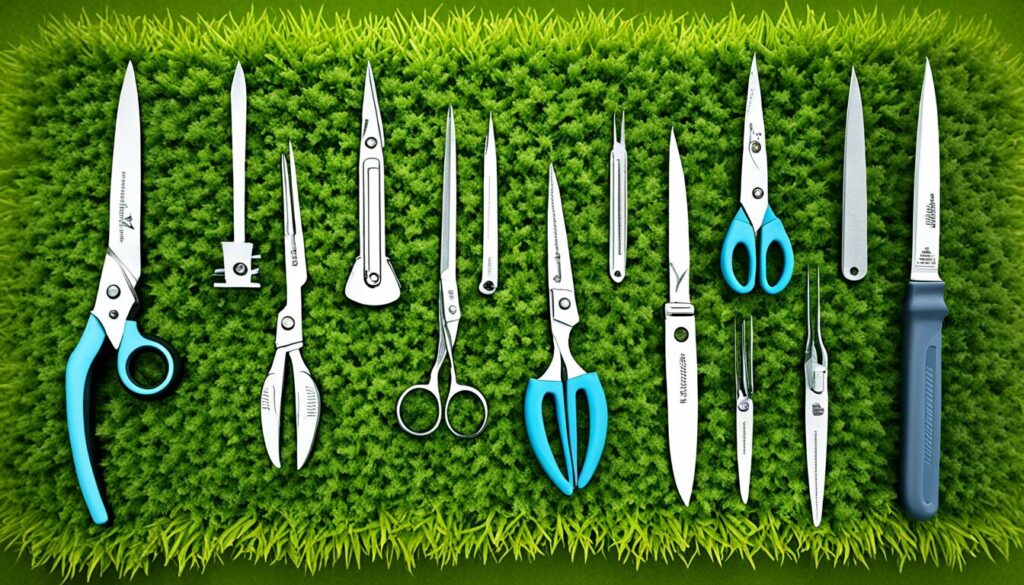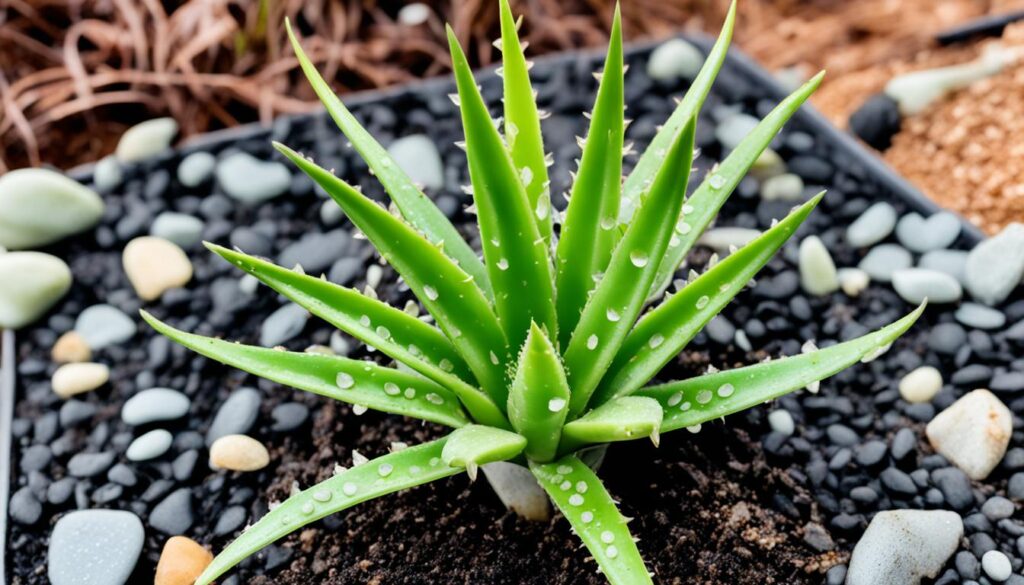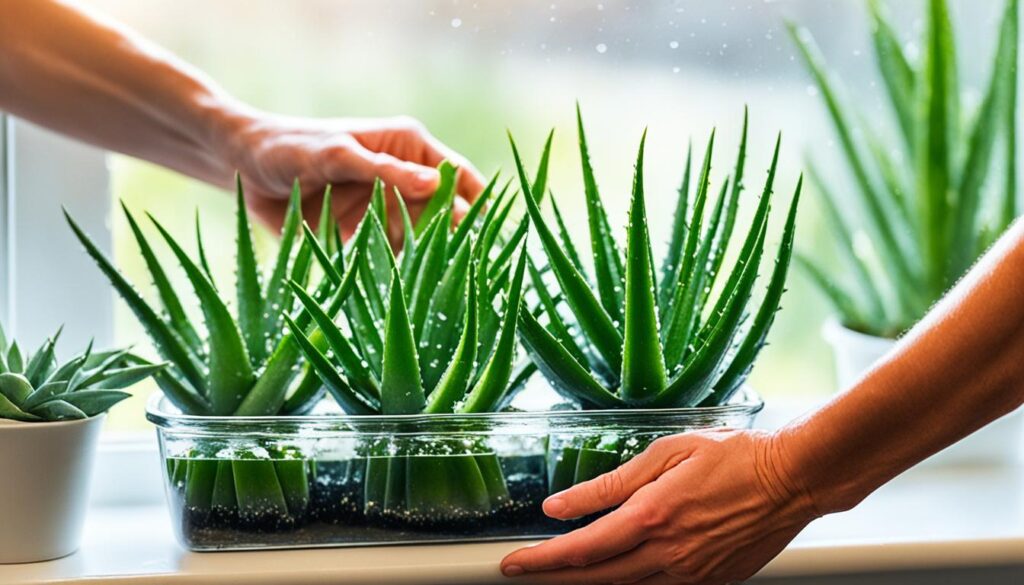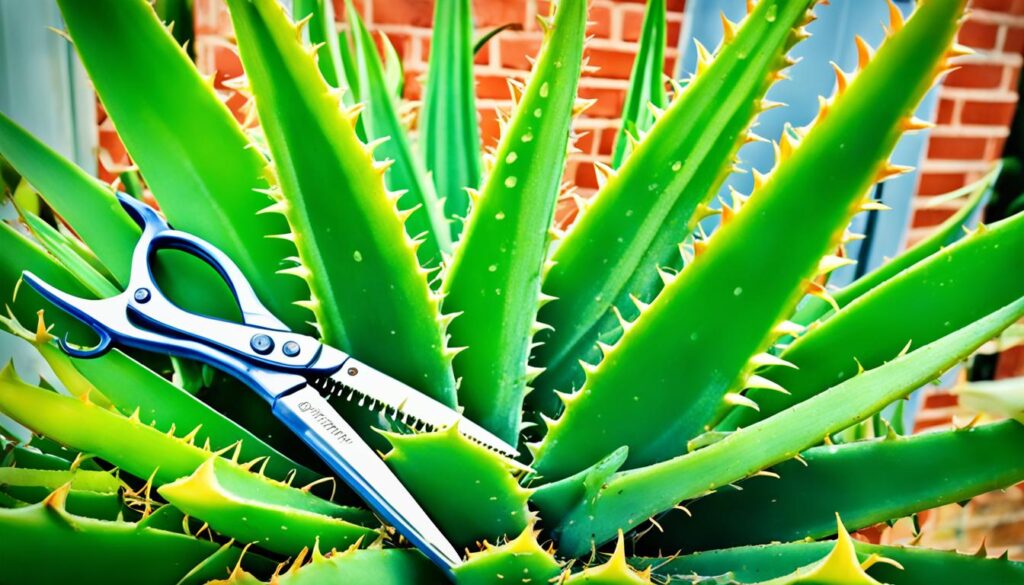More than 70% of aloe plants need proper pruning to stay healthy. Pruning is key for aloe vera care. It helps control size, shape, and health. Whether you’re new or experienced, learning how to prune aloe can help your plants thrive.
This guide will show you how to prune your aloe vera plants right. We’ll cover choosing the right tools and keeping your plants healthy. By following these tips, you can make your aloe plants look great, encourage new growth, and even grow new plants.
Key Takeaways
- Proper pruning is essential for maintaining the health and vitality of aloe vera plants.
- Single-bladed knives are considered the best pruning tools for aloe vera due to their precision.
- Removing dead, damaged, or yellow leaves helps promote new growth and maintain the plant’s aesthetics.
- Separating and transplanting aloe pups can prevent imbalance and enhance overall growth.
- Understanding the growth cycle and proper care techniques is crucial for successful aloe vera pruning.
Inspect Your Aloe Vera Plant Before Pruning
Before you start pruning your aloe vera plant, inspect it carefully. This helps you spot uneven growth or damage. It also lets you check the plant’s shape and structure. By doing this, you can make smart choices about pruning and keep your plant healthy.
Look for Signs of Uneven Growth or Damage
Look at your aloe vera plant for uneven growth. Check if leaves are longer on one side or if the plant leans. These signs might mean there are problems that need fixing before you prune. Also, watch for damaged leaves that are discolored, wilted, or deformed. These need attention too.
Evaluate the Plant’s Overall Structure and Shape
Step back and look at your aloe vera plant’s structure and shape. Is it balanced and even, or does it look off-center? Finding these issues helps you know which parts to remove while pruning. This keeps your plant looking healthy and balanced.
“Proper inspection of your aloe vera plant before pruning is crucial for maintaining its health and appearance. By identifying any signs of damage or uneven growth, you can make informed decisions about the pruning process and ensure the long-term well-being of your plant.”
Inspecting your aloe vera plant before pruning is key to doing it right. It ensures the process is effective and good for the plant. This careful attention will help you keep your aloe vera plant thriving and healthy.
Select the Right Pruning Tool
Choosing the right tools is key when pruning your aloe vera plants. Stay away from big, clumsy tools that are hard to move through the thick leaves. Go for a sharp, single-bladed knife or a pair of clean, sharp scissors instead.
Use a Sharp, Single-Bladed Knife or Scissors
A sharp, single-bladed knife or scissors are top choices for aloe vera pruning. They let you make clean cuts without harming the plant’s tissues. Using dull blades can harm the leaves and slow down the plant’s healing.
Sterilize Your Pruning Tool with Alcohol
Before pruning, make sure to sterilize your tool to stop pests or diseases from spreading. Clean the blade with a cotton ball dipped in ethanol or isopropyl alcohol. This removes sap and prepares your tool for use.

Using the right tools and sterilizing them keeps your aloe vera plants healthy. The right tool makes a big difference in pruning success.
Remove Dead or Damaged Leaves
Keeping a healthy aloe vera plant means removing dead or damaged leaves. These leaves can be hard to handle because they are tough. It’s important to remove them to keep your aloe plant healthy.
Dealing with Tough Aloe Vera Leaves
Dead or severely damaged aloe vera leaves are hard to remove. You’ll need a sharp, clean pair of pruning shears or scissors for this. Cut the dead leaves at the base of the stem, making sure not to damage the healthy parts.
If the leaves are very tough, you might need to use more force. Be gentle but firm, and clean your tools before and after use. This prevents diseases or pests from spreading.
Removing these unhealthy leaves makes your plant look better and stops problems from spreading. This step is key to keeping your aloe vera plant healthy and full of life.
Prune Off Old Yellow Leaves
As your aloe vera plant grows, older leaves at the bottom may turn pale green or yellow. This means the plant is moving nutrients to new leaves. While yellow leaves aren’t a big worry, you can cut them off if they look bad. But, don’t remove too many, as they help with photosynthesis and growth.
Yellow Leaves Indicate Lack of Nutrients
The yellowing of aloe vera leaves often means the plant lacks nutrients. Aloe vera does best in soil that drains well and is rich in nutrients. Without enough nutrients, older leaves turn yellow and get weak. Cutting off these yellow aloe vera leaves helps the plant focus on new, healthy growth.
“Proper pruning is essential for maintaining a lush, vibrant aloe vera plant. Removing the older, yellowing leaves allows the plant to redirect its resources to the younger, more vibrant foliage.”
When pruning yellow aloe vera leaves, use a clean, sharp pair of scissors or pruning shears. Cut the leaves at the base, avoiding the stem or new growth. Throw away the pruned leaves to prevent pests or diseases from spreading to the plant.

Regular pruning of yellow aloe vera leaves keeps your plant healthy and thriving. By removing nutrient-deficient leaves, the plant can focus on new, healthy growth. This ensures its long-term health and vitality.
Cut Away the Withered Flower Stalk
If your aloe vera plant blooms, you’ll need to cut off the withered flower stalk after the flowers fade. This step is key to pruning your aloe vera after it blooms. Use sterilized pruners or shears for a clean cut at the stalk’s base. Don’t saw back and forth, as it can leave a rough edge.
Removing the dried flower stalk does two main things. It makes your aloe vera plant look better and more neat. It also helps the plant focus its energy on growing new leaves, making it healthier and more lively.
“Pruning the withered aloe vera flower stalk is a crucial step in maintaining the plant’s health and appearance. It’s a simple task that can make a big difference in the overall vitality of your aloe vera.”
Always use a sharp, clean tool when pruning aloe vera after it blooms. Clean your pruners or scissors with alcohol before and after to stop diseases or pests. Make sure your cut is straight and clean at the stalk’s base.
By cutting off the withered flower stalk, you’re making your aloe vera plant look better and helping it grow. This easy step is vital for pruning and keeps your aloe vera healthy and strong for many years.
Separate and Transplant Aloe Pups
If you have a mature aloe vera plant, you might see small, baby plants, or “pups,” at its base. These pups are a natural way for aloe vera to spread. You can remove and transplant them into their own pots, growing your aloe collection.
Pups Can Be Removed and Potted Separately
Check the base of your aloe vera plant for small pups. Use a clean, sharp knife or scissors to cut or untangle the pup’s roots from the mother plant. Make sure to get as much root system as you can. This helps the pup grow well after transplanting.
Allow Pups to Callus Before Potting
If the aloe pup doesn’t have roots yet, wait for the cut end to callus over for two to three days before potting. This step prevents infection or pests as the pup grows its roots. After callusing, pot the pup in a well-draining cactus or succulent soil mix.
With care and patience, removing aloe vera pups and transplanting aloe pups helps you propagate aloe vera. This way, you can grow your collection of these tough, useful succulents.

“Aloe vera plants can live for up to twelve years and in that time can produce dozens of babies.”
Root Pruning for Root Rot Issues
Aloe vera plants are usually easy to care for, but they can sometimes get root rot. If you think your plant has root rot, check its roots closely. Healthy roots are off-white, yellow, or pink and soft. Roots that look black, brown, or mushy are probably rotting.
Identify and Remove Rotted or Damaged Roots
Use your clean pruners or knife to cut out any roots that are damaged or rotting. Make sure you leave enough healthy roots to support the plant. Cutting too much can cause the plant to become unstable and stressed.
Signs of root rot in aloe vera include bad smells from the soil, yellow leaves, and the plant wilting. The rotting roots stop the plant from getting water and nutrients, causing the leaves to dry out and wilt.
- Overwatering often leads to root rot in aloe vera plants.
- Leaves with root rot may wilt, twist, and change color.
- Fungus gnats, small flying bugs, love wet soil and can harm plant roots.
Stopping overwatering is key to controlling fungus gnats and preventing root rot. Moving your aloe vera into fresh, well-draining soil can also help it get better.
By quickly finding and removing any rotten or damaged roots, you can help your aloe vera plant get better. Regular checks and good care can stop root rot before it starts.
Watering and Fertilizing for Healthy Growth
Keeping a healthy aloe vera plant is all about the right balance of water and food. Aloe vera can survive with little water, but it needs enough moisture to grow well.
Proper Watering is Crucial for Aloe Vera
When watering your aloe vera, be careful not to overdo it. Water the plant well, but let the soil dry out before watering again. Too much water can cause root rot, which harms the plant. Water your aloe vera 2 to 3 times a month in spring and summer. Cut back to once a month in fall and winter.
Occasional Fertilizing Promotes Leaf Development
Not just watering, but also fertilizing aloe vera is key for its health. A balanced, diluted fertilizer every few weeks in the growing season helps with leaf growth. This is especially true after pruning or moving the plant.
Aloe vera is tough and doesn’t need much food. A light feeding with worm castings in spring can help it get the nutrients it needs.

“Aloe vera plants are recommended to be placed in terra-cotta or similar porous pots to allow the soil to dry thoroughly between watering and prevent rot.”
By following these tips for aloe vera watering and fertilizing aloe vera, your plant will stay healthy and thrive for many years.
How to Prune Aloe Vera
Regular pruning is key to keeping your aloe vera plant healthy and looking great. You might need to trim off damaged or discolored leaves or shape your plant. Let’s go over the steps to prune your aloe vera right and keep it in top shape.
Trim Damaged or Discolored Leaves
First, take a close look at your aloe vera plant. Find any leaves that look damaged, discolored, or unhealthy. Use a sharp, clean tool like a single-bladed knife or scissors to cut these leaves off at the base. This makes your plant look better and stops diseases from spreading.
Cut Away Excess Outer Leaves
Now, step back and look at your aloe vera’s size and shape. If it’s too big or lopsided, it’s time to trim some outer leaves. Choose which leaves to cut, keeping the younger, inner ones. This keeps your plant neat and attractive.
Remember, pruning is important for your aloe vera’s health and life span. By trimming aloe vera leaves and removing outer aloe leaves, your plant will keep thriving and give you its many benefits.
“Proper pruning encourages healthy growth and redirects the plant’s energy to promising areas.”
Storing and Using Pruned Aloe Leaves
When you prune your aloe vera plant, the trimmed leaves are very useful. They hold the plant’s aloe vera gel, which is great for medicine and skincare. To keep the gel fresh, store the pruned leaves right.
Refrigerate Leaves for Later Use
First, remove the thorny edges from the leaves. Then, put them in an airtight container or a resealable bag. Keep them in the fridge to keep the aloe vera gel fresh and strong for later.
Recently, there’s been a big increase in “aloe vera” searches on Amazon.com’s Patio, Lawn & Garden section. This shows more people are interested in the plant and its uses. By storing your pruned aloe leaves right, you can always have this useful natural ingredient on hand.
To use the aloe vera gel, just take a leaf from the fridge, cut it open, and scoop out the gel inside. This gel can help with sunburns, moisturize skin, or be used in DIY beauty and wellness recipes.

Storing and using your pruned aloe vera leaves well can make the most of this amazing plant. With some planning, you can enjoy aloe vera’s soothing and nourishing effects even after trimming your plant.
Repotting and Transplanting Aloe Vera
If you love aloe vera repotting, you might need to move your plant sometimes. This is usually needed when it’s too big for its pot or if you see signs of root rot or too many plants together. Moving your aloe vera the right way helps keep it healthy and strong.
When to Repot or Transplant Your Aloe
The best time to move your aloe vera is in spring or early summer when it’s growing fast. Watch for these signs that it’s time to move your aloe vera:
- The plant is too heavy and can’t stay stable in its pot.
- Roots are showing outside the drainage holes or on the soil surface.
- The plant isn’t growing anymore, showing it needs a bigger pot.
- The soil takes too long to dry out, meaning it’s too wet.
When you repot, use a potting mix made for succulents and cacti. Pick a pot that’s only 1-2 inches bigger than the old one. This lets the plant grow but still drains well.
“Proper repotting and transplanting techniques are essential for keeping your aloe vera healthy and thriving.”
Transplanting your aloe vera can also help you make new plants. Just take the plant out of its pot, separate the pups, and put each one in its own pot.
Let any new plants sit for a few days before putting them in their new spots. This helps stop rot and helps the roots grow strong.
By following these tips for repotting and transplanting aloe vera, you can keep your plant happy and looking great in your home or garden.
Common Reasons for Pruning Aloe Vera
Pruning your aloe vera plant is key to keeping it lush and vibrant. It’s important for the plant’s health and looks. Here are a few reasons why pruning is a must.
Controlling Size and Shape
Pruning helps control the size and shape of your aloe vera. If not trimmed, it can grow too big and look uneven. By cutting off the outer leaves, you encourage a neat, balanced growth. This keeps your aloe looking tidy and healthy.
Removing Damaged or Dead Growth
Pruning is also vital for getting rid of damaged, diseased, or dead leaves. These can attract pests and spoil the plant’s look. Regular checks and trimming keep your aloe looking great and healthy. Controlling size and removing damaged parts are top reasons for pruning aloe vera.

“Proper pruning is essential for maintaining a healthy, vibrant aloe vera plant. It helps control growth, improve appearance, and prevent the spread of any issues.”
Make pruning a regular part of caring for your aloe vera. It keeps the plant in check and fixes any issues. With proper care, your aloe vera will thrive for many years.
Aloe Vera Propagation through Pruning
Pruning your aloe vera plant keeps it healthy and gives you a chance to make more plants. You can use the pups or offsets and pruned leaves to grow new plants. This way, you can share with friends or add to your collection.
Grow New Aloe Plants from Pups
Pups or offsets grow around your aloe vera plant’s base. You can take these and pot them to make new plants. After removing the pups, let the cut ends dry, then plant them in good soil. With care, these pups will grow into new plants for you to enjoy.
Propagate from Pruned Leaves
You can also grow new plants from pruned aloe vera leaves. Aloe vera propagation from leaves is easy. Just let the cut leaf dry, then plant it in soil and keep it moist. With time, the leaf will grow roots and become a new plant.
Using pruning to propagate aloe vera is a great way to grow more plants. Whether from pups or leaves, this method helps you increase your collection of these useful and pretty plants.
Maintaining a Healthy Aloe Vera Plant
Regularly pruning your aloe vera plant is key to keeping it healthy. By cutting off dead or damaged leaves, you control the plant’s size and shape. This also helps you make new plants, keeping your aloe vera happy for many years.
Pruning is a big part of aloe vera plant care. It keeps the plant healthy and looking good. It also encourages new growth and stops problems like too many plants together or diseases. Here are some tips to keep your aloe vera in great shape:
- Use clean, sterilized tools to avoid spreading infections or pests.
- Pay attention to watering and fertilizing, as these are key for growth.
- Remove dead or damaged leaves to stop bacteria and pests.
- Take off any yellow or discolored leaves, which might mean the plant lacks nutrients.
- Separate and move any offsets or “pups” to help the plant grow stronger.
With the right pruning and care, your aloe vera will look lush and healthy. It will also give you lots of that healing gel. Keeping up with maintaining healthy aloe vera means your plant will do well for years.
“The key to a healthy aloe vera plant is regular, gentle pruning and attentive care. With the right approach, you can keep your aloe looking its best and enjoying its many benefits.”

Conclusion
Proper pruning is key to keeping your aloe vera plant healthy and thriving. This guide shows you how to keep your aloe vera strong and ready to use. It’s important for getting its soothing benefits for many years.
Start by checking your plant for damage. Then, remove dead, yellow, or too many leaves. This keeps the plant the right size and encourages new growth. Don’t forget about root pruning to fix root rot and dividing to make new plants.
Regular, gentle pruning, along with the right watering and fertilizing, keeps your aloe vera in top shape. With the right care, your aloe vera will keep thriving. It will be a valuable and beautiful part of your home or garden. Learning how to prune your aloe vera ensures it stays a trusted part of your household for years.


